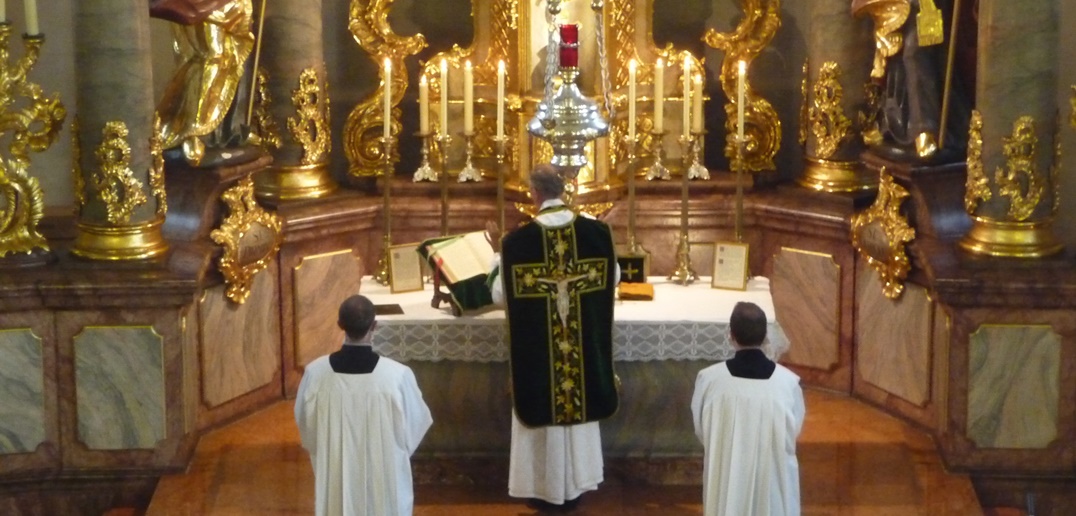
It is integral to human nature: our focus is principally determined by what we are looking at. When we speak to others, we make eye contact. When we move from place to place, we point ourselves in that direction. Pilots face forward. Drivers too. Surgeons don’t stare at the back wall of an operating theater. I’ve yet to meet a cook who can make a meal with their back to the stove. Soldiers don’t march backwards. Writers stare at their screens (or if they’re old-school, their notepads.)
Taken to a deeper level, lovers gaze longingly at their beloved. When someone is in love, distractions disappear. Think of a bride and groom at a wedding. Gathered there are many of the most important people in the lives of the happy couple, and yet where is their attention focused? It is not a question of not loving those gathered to celebrate the wedding vows; it is a matter of prioritizing those who are making them. Their union, their sacrament…transcends.
In all aspects of human existence, we keep the objects of our adoration, contemplation, love, and most importantly, our worship before us. This is who we are. This is what we do.
So when someone tells you that there’s a problem with ad orientem worship, if they say that facing God when worshiping God Him is a problem, that this practice serves as a distraction, is ahistorical, causes disunity, etc. they’re simply not telling you the truth.
An obvious question makes the situation clear: “Did Mary, Mary Magdalene, and St. John turn their backs on Our Lord on Calvary, as He suffered and died?”
Of course not. And yet every Mass places us at the foot of that self-same cross.
If you’re a bishop and you’re peddling excuses about why you “expect” your priests to offer Mass facing the people, instead of the God they’ve come to worship, you’re giving them stones instead of bread. If you resort to the claim that there’s a preference in the General Instruction for the Roman Missal for turning your back on the God you claim to worship (there isn’t; it’s a pernicious myth based on a mistranslation), you owe it to yourself, the priests who have vowed obedience to you, and the faithful of your diocese to tell the truth – the whole truth.
This entire opposition to ad orientem worship — the way the Church has worshiped since apostolic times, as more and more historical research has shown — is a made up controversy that demeans the True Sacrifice of the Altar. Some say it’s about power. Some about ecumenism. Some say it’s simple ignorance. It doesn’t really matter what the reason is. Bishops, have a moral duty to combat such error, not promote it. Further, bishops do not have the authority to forbid ad orientem worship, even in their own dioceses.
Whom is it that you worship, your excellencies? If it is The Lord, then why do you turn your backs on Him?
I suggest to all of you who would like to see your bishops permit reverent liturgy — liturgy in which the priest leads the faithful in worship of God, facing Him together in the same direction — that you first pray for their enlightenment, and if necessary, for their conversion to the fullness of our Catholic faith and due reverence to the Eucharist. Second, send them some version of the letter we provided asking for ad orientem worship.
If all else fails, I suggest that you immediately cease any financial support of any diocese guilty of aggravated assault against ad orientem worship, the TLM, or orthodoxy in general. I would suggest that you not only put a stop to your direct financial support through things like annual bishops’ appeals, but also any non-earmarked funds to your parish that might be confiscated by the diocese. (If you want to support your pastor, ask him if there’s a way you can do so that is not subject to diocesan confiscation.) It is imperative that you not merely abstain from contributing; you must put an explanatory note in your bishop’s annual appeal envelope (or send it directly to the chancery) giving the exact reason why you didn’t donate, and how much you would be willing to if they would merely nourish the faithful with all that the Church has to offer for the salvation of souls. A friend of mine suggested placing your weekly tithe into an interest-bearing account for a time, and sending a printout of the balance (once it has reached a sufficient size) along with your note.
There are also lots of other worthwhile places to contribute to the work of the Church that won’t fund the pet projects of bishops who despise the Church’s perennial liturgical wisdom.
Some will say that this is precipitous, that we should kill the bishops with kindness, that we should beg and plead for scraps from their tables. This is what people did during the bad old days of the TLM “indult,” and many, if not most, were treated like outcasts for their trouble. Even post-Summorum Pontificum, we have to fight for every inch of ground in most places, simply to worship as the Church always has. We’re not asking for something new and inappropriate; we’re asking for something ancient, venerable, and established. We shouldn’t be reduced to such measures, but we’re left with little choice.
We shouldn’t allow another dollar of ours to fall into the hands of bishops who defraud their flocks of true liturgy, good theology, or authentic Catholicism. Enough is enough. Defund bad bishops. Start today.


